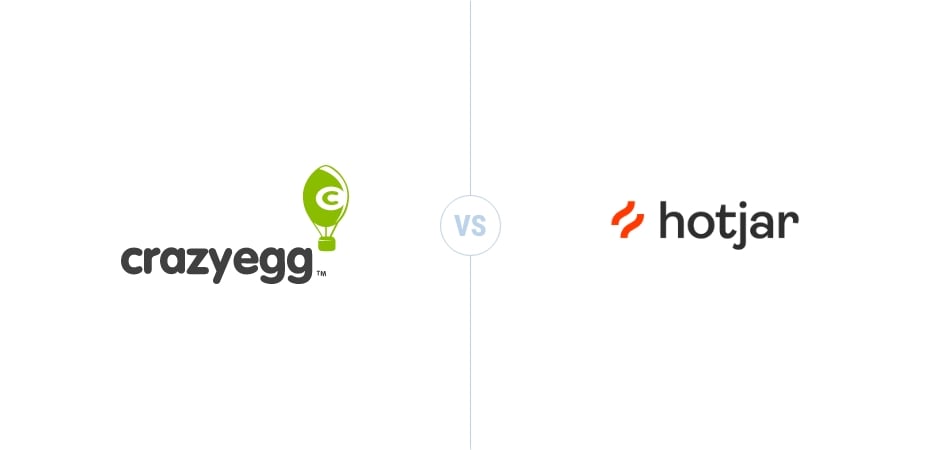If you’re serious about conversion rate optimization (CRO), you need to test and measure, collect feedback, make adjustments based on that feedback and test again until you finally get your page converting. Heatmap software like Crazy Egg and Hotjar can help with this, but which one’s really the best?
Crazy Egg vs Hotjar: Compared Feature Matrix
Key Features
Heatmaps in fact come in 3 shapes. Clickmaps are but one of them and they track the number of clicks (or taps- if we’re talking about mobile devices) on a particular page and their respective locations. In this regard, Hotjar and Crazy Egg are pretty similar. They both offer the clickmap tool and their visual representations range from hot (bright red on Hotjar’s scale vs brilliant white on Crazy Egg’s) to cold (blue) in color.
Pricing
Both Hotjar and Crazy Egg offer this feature. Why is that important ? Because it allows you to see what’s hot and what’s not and can help you decide whether some elements on your page would do better in a different area where they are more likely to get clicks. For example, a particularly bright part of your page is usually a great place for a call-to-action (CTA) button.
However, Hotjar’s scroll map depicts what percentage of users have made it to a particular section of your page vs Crazy Egg’s scroll map that is a visual representation of the amount of time that visitors spend viewing certain sections of your page.
Multi Device Analysis
Both tools offer multi device analysis. With Crazy Egg you can add a snapshot and choose whether you want to exclusively track people using a certain type of device or track across all devices, vs Hotjar where you can select between displaying data generated from different devices at just the click of a button.
Click Data Segmentation by Source of Traffic
In the Hotjar vs. Crazy Egg battle, the latter wins this one. While both tools offer data segmentation, only Crazy Egg has the option of segmenting data by source of traffic. This nifty little feature is actually part of their larger Confetti function.
Confetti Reports
The Confetti report is a heat map taken to a much, much deeper level. With confetti, you will be able to distinguish all the clicks you get on your site segmented by referral sources, search terms & more. Dots or clicks belonging to the same category have the same color.
Conversion Funnels
Conversion funnels report is an advanced feature until recently available within Hotjar. This was considered useful by some users for determining where drop offs in the conversion process occurred. However, Hotjar decided to retire the feature back in December and focus on other tools that add more significant value to its users, after sharing that Hotjar Funnels accounted for only 6% of monthly activity.
Eye Tracking / Move Maps
Studies show that people tend to hover their mouse over areas of the screen where their attention is concentrated. That’s how the term eye-tracking was coined. This type of move heatmap, follows a similar pattern to the click map, but allows users to see over which areas visitors hover in-between clicks. Both Crazy Egg and Hotjar have this function.
Session Recording
One super important feature, session recording couldn’t have been missing from this Crazy Egg vs Hotjar review. Thankfully, both tools offer it. And while you get 100 recordings on both of their base plans, Hotjar will store these recordings for you for up to 365 days (limited to 300 sessions), vs Crazy Egg which will only store your recorded sessions for 3 months.
Heatmaps and Recording Sharing
On top of being able to build your team on the platforms themselves thus granting multiple people access to relevant Behaviour Analytics data, both Hotjar and Crazy Egg let you share heatmaps and recordings with people outside the platform.
Rage Click Tracking
Hotjar offers the option of a ‘rage click’ filter’ on their business plans. This helps you zero in on sessions where users click repeatedly, likely out of frustration. Reviewing some of these recording sessions will help you find out in which areas your visitors are struggling and what might have gone wrong.
Polls and Surveys
This is where Hotjar really shines: they give you the opportunity to collect direct feedback from visitors and add a qualitative level to your website data with a Polls and Surveys feature built right into the product. Crazy Egg, on the other hand, integrates with SurveyMonkey to accomplish this.
A/B Testing
A/B testing is where Crazy Egg comes out on top in the battle against Hotjar : it has a built-in feature that enables you to see how specific changes in website design affect user behavior. Sometimes, getting a better conversion rate could be as simple as moving a ‘BUY NOW’ button around on the page, but you’ll never know unless you test it.
Websites Powered
Both tools have gained a large client base, with Crazy Egg being used by over 300.000 websites, while HotJar powers about 900.000. Among their most famous clients, we can name IKEA, Panasonic, and Nintendo for Hotjar. Although the one with the lower market share between the two, Crazy Egg can boast about being used by major companies such as Dell, Optimizely, and Etsy.
Price Plans
Sometimes, the differentiating factor between 2 similar tools is their price point.
Although Hotjar has always had a Free Forever base plan,it’s also the one with the more prohibitive paid plans. Their prices range from €39 a month to €989, based on the number of page views, perhaps making it too costly for occasional use.
Crazy Egg’s price plans range from $24 a month for a Basic Plan to $249 for their PRO Plan, which offers 500,000 tracked pageviews / month, 100 different snapshots and 5,000 recordings.
Crazy Egg vs Hotjar – How are They Different ?
The answer here is that they aren’t that different. Essentially, both HotJar and Crazy Egg are heat mapping tools that offer pretty much the same core functions.
With that being said, an important distinction can be made when it comes to certain nuances that either developer has decided to concentrate on.
If you need to talk with your website visitors one-to-one, Hotjar is the tool for you. Polls, surveys and feedback widgets can be integrated to collect feedback, and although they offer limited customization, you will find that it’s usually enough to reach your goals.
Crazy Egg however, is a preferable option if what you want to focus on is behavior analytics.
Its famous Confetti feature segments user behavior data by traffic sources and 19 other factors, and its A/B testing feature makes Crazy Egg a popular tool among web designers. Together, these two features provide you with additional insight into the click and movement patterns of different demographics, which is a bit more useful for holistically understanding user behavior.
Both tools also have very good ease of use, ease of installation as well as overall reviews, with Hotjar holding the slightly higher score on TrustRadius .
In conclusion, if the differences between Hotjar and CrazyEgg weren’t enough to sway you in the direction of one or the other, we recommend that you first test the free versions or take advantage of the free trials both of these tools offer to see how they work and find out which option meets your business needs best.



